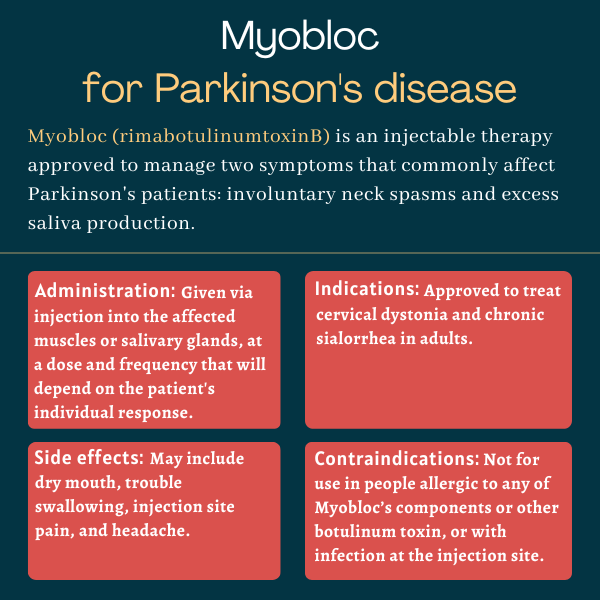
Myobloc (rimabotulinumtoxinB) for Parkinson’s disease
Last updated March 4, 2024, by Marisa Wexler, MS

What is Myobloc for Parkinson’s disease?
Myobloc (rimabotulinumtoxinB) is an injectable medication approved to help manage cervical dystonia (involuntary movements of the neck) and sialorrhea (excessive salivation or drooling), two symptoms that commonly affect people with Parkinson’s disease.
Originally developed by Elan Pharmaceuticals, the therapy is currently distributed by Solstice Neurosciences, a wholly owned subsidiary of Supernus Pharmaceuticals.
Therapy snapshot
| Brand name: | Myobloc |
| Chemical name: | rimabotulinumtoxinB |
| Usage: | Used to help manage uncontrolled neck movements and excessive saliva production |
| Administration: | Injection into neck muscles or salivary glands |
How does Myobloc work?
Myobloc is a type of botulinum toxin, which is a neurotoxic protein known for its ability to block nerve signals in muscles, leading to temporary muscle paralysis. The toxin is produced by the bacteria Clostridium botulinum.
The medication specifically contains a form of purified botulinum toxin type B, which works by interfering with the release of acetylcholine, a chemical signal that plays a key role in muscle contraction. The toxin inhibits the release of acetylcholine from nerve endings at the neuromuscular junction, where nerve and muscle cells communicate.
Under normal circumstances, acetylcholine signals help to trigger muscle movements and saliva production. By blocking acetylcholine release and preventing the communication between nerves and muscles, Myobloc can induce temporary muscle paralysis in targeted muscles and salivary glands, thereby reducing involuntary muscle contractions in the neck and the production of saliva.
Who can take Myobloc?
Myobloc was initially approved by the U.S. Food and Drug Administration (FDA) in December 2000 to ease pain and reduce the severity of abnormal head positioning associated with cervical dystonia in adults. This made Myobloc the first botulinum toxin type B product to gain FDA approval, and the first neurotoxin approved in the U.S. for cervical dystonia in adults. The medication’s indications in the U.S. were extended in August 2019 to include chronic sialorrhea in adults.
Myobloc also was approved in 2001 in the European Union, where it was sold under the brand name NeuroBloc and was approved only for cervical dystonia. Then the company decided to stop marketing the product.
Who should not take Myobloc?
Myobloc is contraindicated, or not recommended, for anyone with:
- an allergy to any of the medication’s components or any botulinum toxin preparation
- an infection at the proposed injection site.
The therapy’s prescribing information comes with a boxed warning that Myobloc may spread to regions outside the area of injection and result in symptoms consistent with botulinum toxin effects. Such symptoms can occur hours to weeks after the injection, and may include difficulty swallowing and breathing, which can be very serious and sometimes fatal.
How is Myobloc administered in Parkinson’s?
Myobloc is given via an injection into the neck muscles or salivary glands. The medication is available in single-dose vials containing a clear, colorless to light-yellow solution that comes in three dosage strengths:
- 2,500 units/0.5 mL
- 5,000 units/mL
- 10,000 units/2 mL (5,000 units/mL)
When used for cervical dystonia, Myobloc should be injected into the affected cervical muscles by a physician with experience in assessing and managing the condition.
The recommended initial dose for this indication is 2,500 to 5,000 units divided among the affected muscles in patients with a prior history of tolerating botulinum toxin injections. People who haven’t had botulinum toxin injections should start with a lower dose.
In general, Myobloc’s effects tend to last about three to four months when given at dosages of 5,000 or 10,000 units. However, subsequent dosing should be determined based on how the patient responds.
When used for excessive drooling, the medication is injected into the salivary glands. The recommended dose is 1,500 to 3,500 units divided among the parotid glands, which are located below and in front of the ears, and the submandibular glands, which are below the jaw.
The effects of this treatment usually last up to three months but may vary from person to person. The frequency of injections is determined based on how the individual responds, but injections should generally be given no less than 12 weeks apart.
The dosage strength of Myobloc cannot be compared to or converted into units of other formulations of botulinum toxin.

Myobloc in clinical trials
Myobloc’s approvals were mainly supported by data from four Phase 2 and Phase 3 clinical trials, two in people with cervical dystonia and two in patients experiencing excessive drooling.
Trials in cervical dystonia
The two Phase 3 trials that helped support Myobloc’s approval for cervical dystonia collectively enrolled 186 adults who had previously been treated with botulinum toxin A. Patients had at least two muscle groups affected, but no history of a neuromuscular disorder, neck contractures, or other issues that could decrease range of motion in the neck.
In the first study, a total of 109 patients who had experienced an acceptable response to previous botulinum toxin A products were enrolled and randomly assigned to receive either Myobloc — at a dose of 5,000 or 10,000 units — or a placebo into 2-4 affected muscles selected by the investigators.
The second trial enrolled 77 who had initially responded well to botulinum toxin A but stopped responding to later injections. Participants were randomly assigned to a Myobloc dose of 10,000 units or a placebo, administered in 2-4 neck and/or cervical muscles in a single treatment session.
In both trials, the assigned dose was divided by the selected muscles, and each muscle received one-five injections.
The main goal was to evaluate the effect of treatment using the Toronto Western Spasmodic Torticollis Rating Scale (TWSTRS), a score that reflects the severity, pain, and impact on daily living of uncontrolled neck movements, at four weeks post-injection.
Results showed average TWSTRS scores improved by 9.3 to 11.7 points in patients treated with either dose of Myobloc across the studies, whereas in patients given the placebo, average scores improved by less than five points. Myobloc also outperformed the placebo on patient- and clinician-rated measures of overall efficacy.
Exploratory analyses of these two studies suggested most patients who showed a beneficial response after four weeks had returned to their initial status about 12 to 16 weeks after treatment.
In another trial, 145 patients with cervical dystonia were randomly assigned to each receive three treatment sessions of Myobloc at sequential doses of 10,000 units, 12,500 units, and 15,000 units. The sessions took place 12 to 16 weeks apart, regardless of the patients’ response to their previous dose. While both patients and their doctors knew which dose they were receiving at each session, results showed similar improvements in TWSTRS scores at four weeks for all three doses.
Trials in sialorrhea
A clinical trial called MYSTICOL (NCT01994109) enrolled 187 adults, 122 of whom had Parkinson’s, who were experiencing excessive drooling for at least three months. Patients received a single treatment session, in which injections of Myobloc (2,500 or 3,500 units) or a placebo were given into both parotid and submandibular glands.
Four weeks after the injections, the average rate of unstimulated saliva flow had significantly decreased by 0.36 to 0.37 grams per minute (g/min) for patients given either dose of Myobloc, whereas saliva flow decreased 0.07 g/min for patients given the placebo. The difference was statistically significant, meaning the trial met its main goal.
Based on the clinician’s impression of change, chronic sialorrhea was also much or very much improved at four weeks in patients treated with Myobloc at doses of 2,500 units (60%) and 3,500 units (53%). In comparison, 12% of patients on the placebo had similar improvements.
A second trial (NCT00515437) tested Myobloc at doses from 1,500 to 3,500 units against a placebo in 54 Parkinson’s patients who were experiencing excessive drooling. By four weeks after the injection, the average rate of saliva flow was virtually unchanged for patients given a placebo, whereas saliva flow decreased from 0.3 to 0.44 g/min on average in patients given Myobloc at any of the tested doses.
Clinician-rated impressions of overall efficacy favored Myobloc over the placebo, with significant differences being observed for up to 12 weeks after the treatment session.
Common side effects of Myobloc
The most common side effects of Myobloc when used for cervical dystonia included:
- dry mouth
- trouble swallowing
- injection site pain
- headache.
When the therapy was used in trials for sialorrhea, the most common side effects were:
- dry mouth
- trouble swallowing.
Spread of toxin effect
Treatment with Myobloc, like other medications based on botulinum toxin, may cause the effects of the toxin to spread beyond the site of injection, which can occur hours to weeks after the injection. This can lead to symptoms such as muscle weakness, blurred vision, and trouble speaking. It can also cause difficulty breathing or swallowing, which may be life-threatening.
The highest risk is likely in children treated for spasticity (a condition where muscles become stiff, tight, and difficult to control), but adults, especially those with underlying health conditions, can also be at risk. The therapy should be used with caution in patients with pre-existing breathing or swallowing problems.
Allergic reactions
Allergic reactions to Myobloc, including a serious reaction called anaphylaxis, have been reported. Signs of an allergic reaction may include swelling, hives, or rash. If an allergic reaction occurs, the treatment should be discontinued and appropriate supportive care should be given at once.
Swallowing and breathing difficulties
Treatment with Myobloc may cause problems in swallowing or breathing, especially in people with existing difficulties. Difficulty swallowing might last for a few months, and in some cases, a feeding tube may be needed for proper nutrition and hydration. In severe cases, swallowing problems can lead to aspiration, especially in already compromised individuals. If patients experience problems with swallowing, speech, or breathing, they should seek immediate medical attention. These reactions may occur within hours or weeks after Myobloc treatment.
People with conditions marked by a loss of communication between nerves and muscles (including amyotrophic lateral sclerosis, myasthenia gravis, and Lambert-Eaton myasthenic syndrome) should be monitored closely when treated with Myobloc. Those with neuromuscular disorders may have a higher risk of significant side effects, such as severe difficulty in swallowing and breathing, even with typical doses.
Transmission of viral diseases
Because Myobloc contains albumin, a protein derived from human blood, the therapy could potentially cause transmission of viral diseases and variant Creutzfeldt-Jakob disease. However, this risk is considered extremely low, and no cases of these issues related to Myobloc have been reported.
Effects on ability to drive and use machines
Patients should avoid driving or engaging in other potentially hazardous activities if they experience muscle weakness or impaired vision.
Use in pregnancy and breastfeeding
Myobloc has not been adequately studied in people who are pregnant or breastfeeding. In animal studies, injections of Myobloc at doses high enough to be toxic for the mother didn’t cause notable issues for developing fetuses or for babies during breastfeeding. The potential risks and benefits of Myobloc in these situations should be considered carefully by patients and their healthcare teams.
Parkinson’s News Today is strictly a news and information website about the disease. It does not provide medical advice, diagnosis, or treatment. This content is not intended to be a substitute for professional medical advice, diagnosis, or treatment. Always seek the advice of your physician or another qualified health provider with any questions you may have regarding a medical condition. Never disregard professional medical advice or delay in seeking it because of something you have read on this website.
Recent Posts
Related articles




